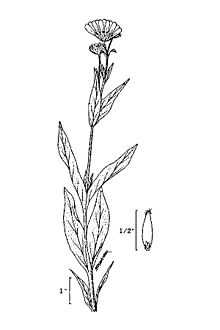Arnica chamissonis
| Arnica chamissonis | |
|---|---|
 | |
| Scientific classification | |
| Kingdom: | Plantae |
| (unranked): | Angiosperms |
| (unranked): | Eudicots |
| Order: | Asterids |
| Family: | Asteraceae |
| Genus: | Arnica |
| Species: | A. chamissonis |
| Binomial name | |
| Arnica chamissonis Less. | |
Arnica chamissonis very similar to Arnica montana. A. chamissonis is found in the United States and surrounding regions while A. montana is found in Europe. A. chamissonis is considered an invasive species in Austria, Denmark, Finland, Norway and Sweden.[1]
Distribution and habitat
A. chamissonis is native to the Western United States, including Alaska, and most of Canada.[2] A. chamissonis is perennial. It has a temperature minimum of −33 °F (−36 °C).[2] They are adapted to both coarse and medium textured soils with a pH between 6.0-7.2.[2] Since this plant uses a lot of moisture, it has a precipitation requirement of between 14–24 inches (36–61 cm).[2] It generally prefers moist meadows and conifer forests and often grows montane and subalpine, 0–3,500 metres (0–11,483 ft).[3]Seeds are easily available and the plant can be grown in a home garden. It prefers full sun exposure and an average soil temperature of 65–75 °F (18–24 °C).[4]
Morphology

A. chamissonis has yellow flowers with green medium textured foliage.[2] The leaves of the Arnica chamissonis are grouped in 4-10 pairs.[3] It produces brown colored seeds and has an active growth period of the spring and summer. It has rhizomatous growth and grows at a moderate rate.[2] Rhizomatous plants have an under ground stem with small fiber-like adventitious roots. A. chamissonis has a mature height of roughly 2.5 feet (76 cm).
Reproduction and growth
A. chamissonis has an active bloom period throughout the summer.[2] There are approximately 400,000 seeds per pound. These individuals have a medium seedling vigor and a moderate vegetative spread rate.[2] Seedling vigor refers to "the expected seedling survival percentage of the plant compared to other species with the same growth habit." A vegetative spread rate refers to how quickly a plant can spread through a given area. In general, A. chamissonis can be grown in a container, by using seeds or sprigs.[2]
Both the A. montana and the A. chamissonis share the toxin helenalin.
References
- ↑ "Invasive Species Compendium, 2011 Edition". CAB International, Wallingford, UK, 2011.
- ↑ 2.0 2.1 2.2 2.3 2.4 2.5 2.6 2.7 2.8 National Plant Data Team (2012). "The PLANTS Database". USDA, NRCS.
- ↑ 3.0 3.1 "eFloras". Missouri Botanical Garden, St. Louis, MO & Harvard University Herbaria, Cambridge, MA. 2008. Retrieved 3 May 2012.
- ↑ "Restoration Seeds".